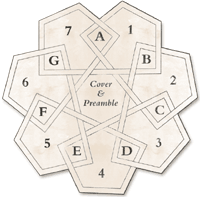1It is possible to navigate this work in at least two ways. On one hand, there is the undertow of a plot line that proceeds from the introduction (1) and a comparison of the studioli contents and their experiential characteristics (2), through an overview of the relation between thinking and making in late quattrocento Italy (3), and its influence on the humanist education of a prince such as Guidobaldo da Montefeltro, as evidenced in the Gubbio studiolo (4 and 5). Chapter (6) explores the Urbino studiolo and its role in an average day in the life of Duke Federico da Montefeltro and is followed by (7) a few concluding thoughts.
2It is not necessary, however, to read these sections in numerical sequence: each is somewhat autonomous. In fact, a nonlinear reading would be in keeping with the transdisciplinary intellectual habits of the studioli patrons and artists, complementing the polysemic nature of the studioli compositions. If you prefer to begin with a sense of how the studioli fit into an average day in the Montefeltro court, then I recommend beginning with chapter 6. Or, if you prefer to equip yourself with a contextual synopsis of late quattrocento views of thought- and material craft, go to chapter 3. If your interests center on pedagogical traditions, begin with chapter 4. You might also use the IAQ (Infrequently Asked Questions) to navigate: they are linked to a sequence of extended captions that cross-reference the main text at critical intervals.
3Whichever path is chosen, readers are encouraged to dither across sections via text, notes, extended captions, images, indexes, and galleries: these various devices extend ancient practices for forming associational links that are embedded in the walls of the studioli. At the time of their construction, the studioli embodied the leading edge in technologies of visual representation, through the arts of intarsia (wood inlay) and perspective. Translation of this research into the digital environment, with assistance from the Gutenberg-e Prize and Columbia University Press, is a natural extension of its historical subject, offering an opportunity to explore how contemporary interactive technologies reactivate and transform ancient metaphors for thought and learning.
^topThe Navigational Icon
4 Navigational iconThe navigational icon for this e-publication is a geometric figure found on the inside of a (true) cabinet door in the Urbino studiolo. It is seven-sided, a heptagon, composed of an infinitely recursive single line. Its form traces a fondness for the number 7 that was culturally shared (seven vices and virtues, seven liberal arts, and so on) and also specific to the studioli and the Urbino court. The selection of a seven-pointed figure for its highly charged location was not taken lightly. Included in this research are speculations about this heptagonal figure and why it might have proved a natural choice as ornament for the Urbino studiolo. For these reasons, it is an ideal icon for organizing and navigating the research. This interactive icon is located directly above the Search button.
Navigational iconThe navigational icon for this e-publication is a geometric figure found on the inside of a (true) cabinet door in the Urbino studiolo. It is seven-sided, a heptagon, composed of an infinitely recursive single line. Its form traces a fondness for the number 7 that was culturally shared (seven vices and virtues, seven liberal arts, and so on) and also specific to the studioli and the Urbino court. The selection of a seven-pointed figure for its highly charged location was not taken lightly. Included in this research are speculations about this heptagonal figure and why it might have proved a natural choice as ornament for the Urbino studiolo. For these reasons, it is an ideal icon for organizing and navigating the research. This interactive icon is located directly above the Search button.
5Please note: Due to differences among computer processors, software generations, and internet buffering, it is recommended that readers replay animations and videos for an unimpeded screening, once they have been downloaded.
^topNavigational Outline
- Cover and Preamble
- Introduction
- The Urbino and Gubbio Studioli: Their Contents, Compositions, and Experiential Character
- 2.1 The Urbino Studiolo
- 2.2 The Gubbio Studiolo
- 2.3 A Phenomenological Reading of the Studioli
- Material and Mental Craft in Quattrocento Italy: Several Hypotheses Concerning the Studioli
- Memory and Quattrocento Learning: The Gubbio Studiolo as a Florilegium for Prince Guidobaldo da Montefeltro
- 4.1 The Humanist Education of a Late Quattrocento Prince
- 4.2 On Right Habits
- 4.3 On Architecture and Memory
- 4.4 Aedificatio: Architecture as a Metaphor for Meditation
- Adumbration: Cosm(et)ology and the Gubbio Studiolo
- The Urbino Studiolo as an Engine for Governance
- 6.1 The Duke's Private Percorso
- 6.2 On Action and Contemplation
- 6.3 The Gallery of the Illustrious (Uomini Illustri)
- 6.4 The Physicality of Thought: Solitude, Solicitude, and Cogitatio
- 6.5 The Roman Cubiculum
- 6.6 FEDE+RICO and the Faithlessness of Princes
- 6.7 The Influence of Politics on Patronage
- 6.8 Temperance and the Golden Mean
- 6.9 On Music and "Right" Leisure
- 6.10 On Chess
- 6.11 On Fortune
- Conclusion: The Studioli as Architecture
- Acknowledgments
- Image, Animation, Video, Slide and Sound Galleries
- Infrequently Asked Questions
- Extended Captions
- Encomia for Gallery of Illustrious Men in Urbino studiolo
- Bibliography
- About the Author